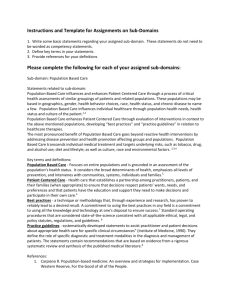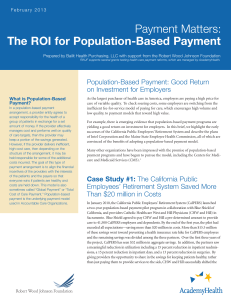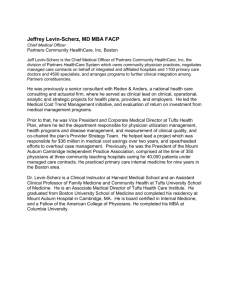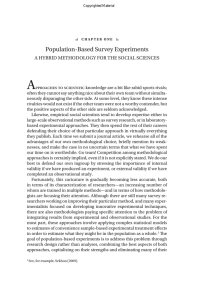Population-Based Health Care: Definitions and Applications
advertisement
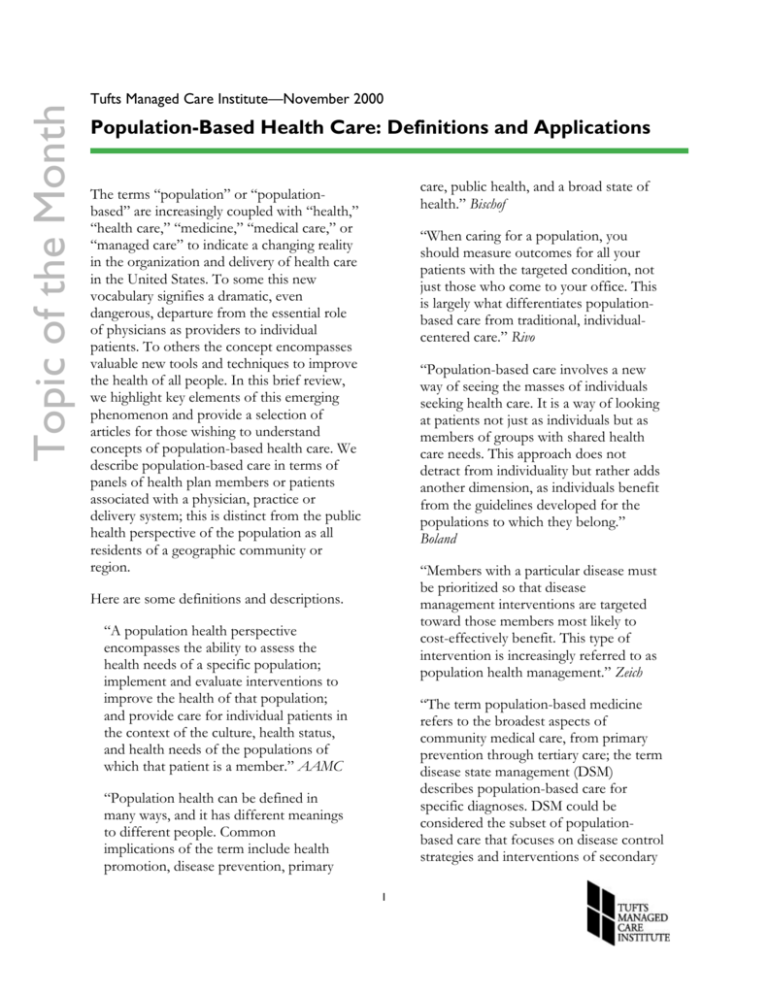
Topic of the Month Tufts Managed Care Institute—November 2000 Population-Based Health Care: Definitions and Applications care, public health, and a broad state of health.” Bischof The terms “population” or “populationbased” are increasingly coupled with “health,” “health care,” “medicine,” “medical care,” or “managed care” to indicate a changing reality in the organization and delivery of health care in the United States. To some this new vocabulary signifies a dramatic, even dangerous, departure from the essential role of physicians as providers to individual patients. To others the concept encompasses valuable new tools and techniques to improve the health of all people. In this brief review, we highlight key elements of this emerging phenomenon and provide a selection of articles for those wishing to understand concepts of population-based health care. We describe population-based care in terms of panels of health plan members or patients associated with a physician, practice or delivery system; this is distinct from the public health perspective of the population as all residents of a geographic community or region. “When caring for a population, you should measure outcomes for all your patients with the targeted condition, not just those who come to your office. This is largely what differentiates populationbased care from traditional, individualcentered care.” Rivo “Population-based care involves a new way of seeing the masses of individuals seeking health care. It is a way of looking at patients not just as individuals but as members of groups with shared health care needs. This approach does not detract from individuality but rather adds another dimension, as individuals benefit from the guidelines developed for the populations to which they belong.” Boland “Members with a particular disease must be prioritized so that disease management interventions are targeted toward those members most likely to cost-effectively benefit. This type of intervention is increasingly referred to as population health management.” Zeich Here are some definitions and descriptions. “A population health perspective encompasses the ability to assess the health needs of a specific population; implement and evaluate interventions to improve the health of that population; and provide care for individual patients in the context of the culture, health status, and health needs of the populations of which that patient is a member.” AAMC “The term population-based medicine refers to the broadest aspects of community medical care, from primary prevention through tertiary care; the term disease state management (DSM) describes population-based care for specific diagnoses. DSM could be considered the subset of populationbased care that focuses on disease control strategies and interventions of secondary “Population health can be defined in many ways, and it has different meanings to different people. Common implications of the term include health promotion, disease prevention, primary 1 1000 or per member per month (PMPM) (e.g, children in the age range receiving vaccinations). Our ability to track these data with ever-improving information systems allows us to seek out quality metrics or patterns of under-utilization as well as overutilization, and to measure and compare how well patients and populations are being served. Without the reinforcement of population-based measures, it is hard to recognize successes and improvements, i.e., true health care improvement (outcomes). prevention, as it usually excludes interventions aimed at primary prevention.” Weiss While their focus may differ, these authors agree that population-based care is a positive force for both treating individual patients and caring for populations. To summarize some of the major themes: Influence of managed care: Managed care has organized populations and panels under the care of delivery systems, practices and physicians. These providers are accountable for the health of all enrollees in their charge, both healthy and those with chronic illnesses. Moreover, they are accountable to varying degrees for the resources and costs of providing this care. So the strategies and tools of population-based care are in part a response to this system, but they also offer benefits to patients in any system of care. “The fundamental principles supporting efforts in population health training exist independently of the managed care delivery system.” (AAMC) The two-way street: Caring for populations and for individuals is complementary, not contradictory. Starting with the population, once a clinical care guideline is established for a certain condition, the physician can apply that guideline to the patients who present with that same condition. Since the guideline is determined and monitored by assessing its effectiveness on a population of similar patients, the physician should have confidence that it does indeed reflect best practice. At the same time, if a physician achieves an efficient process and favorable outcomes with an individual patient, he or she can standardize these steps across all similar patients. In both cases the physician must consider the match between what works in the aggregate for a population and what, if any, unique characteristics of the individual need special attention. Denominator medicine: In the new calculation, individual patients are numerators and the populations to which they belong are denominators. Physicians need to work on both factors: treating individuals and improving collective outcomes. Unlike traditional medicine, managed care creates denominators: all health plan members, or those enrolled with a provider network or physician. Denominators (or populations) can be broken down further into groups with similar demographics (e.g., female patients over age 50) or people with the same disease state or clinical condition. Numerators can be units of service (e.g., screenings, admissions) or costs or numbers of patients. Any combination of numerator and denominator can be standardized, e.g., screening rates per Care for all: Population-based care can extend to an entire community (the public health perspective), to a panel of enrollees (the managed care perspective), to groups of people with similar demographics, and to groups of patients with similar conditions or health status. In the new practice environment, physicians are responsible for panels of patients according to their health plan affiliation. Strategies and tools for addressing these panels in their entirety 2 © TUFTS MANAGED CARE INSTITUTE 136 Harrison Avenue, Boston, MA 02111 • P: 617.636.1000 • F: 617.636.0429 • www.tmci.org include: an epidemiologic assessment to learn about the group’s unique health characteristics and behaviors; risk appraisals to identify common issues and to develop individualized plans; development of or referral to broadbased wellness, health promotion and disease prevention programs (e.g., exercise programs, seat-belt use); reminder calls or cards to subgroups regarding their appropriate screenings and preventive care measures (e.g., reminders to increase influenza vaccinations or mammography rates); and targeted measures to reach individuals who need but would not otherwise present for care. team of clinicians and administrative staff can develop and implement protocols and systems for maintaining health of all population members and for treating those subgroups afflicted with various conditions. While larger, more sophisticated networks can bring to bear more resources and pursue greater numbers of initiatives, even small practices can identify a few population-based activities and designate staff to manage them. The particular efforts depend in part on the extent and automation of the practice’s information systems and their capabilities to define the population and outcomes. Treating conditions: A fundamental component of population-based care is disease-sometimes called disease statemanagement. For some observers the concepts are identical. Underlying disease management is the Pareto principle: among the entire population, a subset of individuals with defined conditions will require the most attention and consume the greatest share of resources; and within each condition-specific subpopulation, patients can be stratified by health status and need. The goal is to determine and apply the best practice to achieve high quality and cost-effective care for each subpopulation and its individual patients. Common conditions addressed in this way include diabetes, asthma, CHF and hypertension. Special interventions are also designed for the high-risk elderly. By thinking in terms of these populations, physicians have the means and the numbers to implement systems and processes of care and to evaluate and improve outcomes. Ethical considerations: For all its potential to improve health care, population-based care still worries some observers. They fear that it will undermine the physician-patient relationship and the function of advocacy for one’s individual patients. Indeed, populationbased care may generate new ethical issues in addition to those already intrinsic to medical practice. The need for change, however, and the benefits of this approach are too powerful to abandon. We close with these excerpts from a statement of ethical principles by a multidisciplinary group calling itself the Tavistock Group: Flaws in the health care delivery system sometimes translate into bad outcomes or bad experiences for the persons served and for the population as a whole. Hence, those working in health care delivery may sometimes be faced with situations in which it may seem that the best course is to manipulate the flawed system for the benefit of a specific patient or segment of the population, rather than to work to improve the delivery of care for all. Such manipulation produces more flaws, and the downward spiral continues. Teamwork: Successful population-based care requires staff and resources beyond what individual physicians do. It involves planning and implementing care for groups, working with patients outside of the office visit, and monitoring effectiveness. A multidisciplinary 3 © TUFTS MANAGED CARE INSTITUTE 136 Harrison Avenue, Boston, MA 02111 • P: 617.636.1000 • F: 617.636.0429 • www.tmci.org The care of individuals is at the center of health care delivery but must be viewed and practiced within the overall context of continuing work to generate the greatest possible health gains for groups and populations. Magazine. September 1998;7(9):24ff. http://www.managedcaremag.com/archiv eMC/9809/9809.population.shtml • Greenlick MR. Educating physicians for population-based clinical practice. JAMA. March 25, 1992;267(12):1645-1648. By adopting this approach as a guiding principle and applying the tools of population health care, everyone involved in health care can help to improve the delivery of care for the benefit of all patients. • Kirsner R, Federman D. The ethical dilemma of population-based medical decision making. The American Journal of Managed Care. November 1998;4(11):1571-1576. References • Rivo M. It’s Time to Start Practicing Population-Based Health Care. Family Practice Management. June 1998;5(6). http://www.aafp.org/fpm/980600fm/pop based.html • Association of American Medical Colleges (AAMC), Medical Informatics Panel and the Population Health Perspective Panel. Contemporary issues in medical informatics and population health: report II of the Medical School Objectives Project. Acad Med. 1999;74:130-141. Association of American Medical Colleges (AAMC). Abstract: www.academicmedicine.org • Smith R, Hiatt H, Berwick D. A shared statement of ethical principles for those who shape and give health care: a working draft from the Tavistock Group. Annals of Internal Medicine. January 19, 1999;130:143-147. http://www.annals.org/ • Related AAMC Press Release, AAMC Stresses Value of Population Health In Medical Education, May 28, 1998. http://www.aamc.org/newsroom/pressrel /980528.htm • Taplin S, Galvin M, Payne T, Coole D, Wagner E. Putting Population-Based Care Into Practice: Real Option or Rhetoric? Journal of the American Board of Family Practice. March/April 1998; 11(2):116-126. http://www.familypractice.com/references /referencesframe.htm • Bischof R. Population Health Assessment. March 1998. HealthAtoZ Professional CME Program. • Weiss K. A look at population-based medical care. Disease-a-Month. August 1998;44(8):353-369. • Boland P, editor. Redesigning Heath Care Delivery. Boland Health Care, Berkeley, 1996. pp. 159-163. • Zeich R. Patient identification as a key to population health management. New Medicine. 1998;2:109-116. • Dalzell M. Just what the devil is population-based care? Managed Care 4 © TUFTS MANAGED CARE INSTITUTE 136 Harrison Avenue, Boston, MA 02111 • P: 617.636.1000 • F: 617.636.0429 • www.tmci.org Authors Ralph Halpern Director of Content Development and Program Evaluation Tufts Managed Care Institute Philip Boulter, MD Medical Director Tufts Managed Care Institute, and Senior Vice President and Chief Medical Officer Tufts Health Plan 5 © TUFTS MANAGED CARE INSTITUTE 136 Harrison Avenue, Boston, MA 02111 • P: 617.636.1000 • F: 617.636.0429 • www.tmci.org
